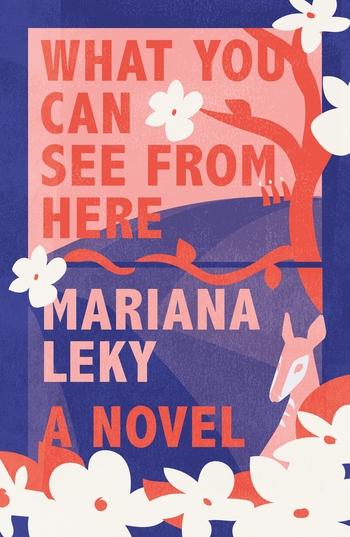Book Review: “What You Can See From Here” – Hopefully Romantic
By Melissa Rodman
There is enough candor and humor, along with a handful of bracingly moody characters, to make Mariana Leky’s vision of perpetual love compelling.
What You Can See From Here by Mariana Leky. Translated from the German by Tess Lewis. Farrar, Straus and Giroux, 336 pages, $27.

I’ve been mulling over how the stock phrase “hopelessly romantic” can be seen as an oxymoron, the downbeat tone of the first word pitted against the optimistic pull of the second. For most people, including fictional characters yearning for love, doesn’t hope, perpetually on the horizon, beckon the heart forward even when the going gets tough?
Most of the characters in Mariana Leky’s international bestseller What You Can See From Here would answer with a resounding yes. Originally published in German in 2017, this warmhearted bildungsroman is set in the Westerwald, a mountainous region in the western part of Germany. The narrative focuses on three slices of protagonist Luisa’s life — childhood, adolescence, and early adulthood — with generous forays into the lives of quirky characters who weave through her story. Because it is such a small village, Luisa and the ensemble are intertwined, both in life and in dreams. Nodding off after listening to a bedtime story told by her grandmother, Selma, Luisa reflects, “I pictured the optician grinding lenses, Martin lifting a heavy weight, Elsbeth trimming her hedges, the shopkeeper stacking cartons of juice, my mother layering fir branches, my father writing out prescriptions, all exactly to the beat of Selma’s heart.”
Luisa is 10 at the beginning of the novel, and Selma has had a consequential dream of her own: nightgown-clad, Selma stands near an okapi in a meadow in the Uhlheck (the owl forest, where she routinely walks). “She glanced at the okapi now and then from the corner of her eye, looking up at it from below, the way you look at someone you love far more than you’re prepared to admit.” Those who hear about Selma’s dream are not taken by its picturesque visuals. Their reaction is fear: following the three previous times Selma dreamt about the okapi, someone died.
As whispers of Selma’s dream ripple around town, no one is taking any chances. In a humorously macabre montage, the villagers modify their steps with survival in mind. They train their eyes upward “to rule out falling roof tiles, branches, or heavy light fixtures” and eye one another suspiciously, “to check if someone with bloodlust were about to pounce.” Before the mortal blow arrives, some of the population wrestle with disclosing their “hidden truths.” Some of these secrets, like the optician’s decades-long love for Selma, are not as well hidden as the keepers thought. Returning to the hopeless-romantic spectrum, the novel gravitates toward love (both platonic and passionate) rather than the blues, even after the anticipated death occurs in a devastating, unexpected way. In its wake, Luisa tells Selma, “I don’t want to grow up.” Selma responds, “I know… But we’d be very happy if you decided to grow up anyway.”

Author Mariana Leky. Photo: Franziska Hauser
And since that’s only the first third of the book, Luisa does grow up. The timeline of the novel’s final two sections proceeds at a quicker clip, with Luisa portrayed from 22 through 32, as a romantic attraction propels the narrative. While searching for the family’s dog, Alaska, who has run away, Luisa bumps into three Buddhist monks in the Uhlheck. The “monk in the middle,” who accompanies Luisa when the search party fans out, morphs from stranger to confidant to lover. His name is Frederik and — through ups and downs, goodbyes and hellos, across time zones, kilometers, and spotty telephone connections between the Westerwald and Japan — the two are pulled together like magnets. At their first unavoidable parting, Luisa jams her foot (literally) in a closing door. At the time, she is meditating on her evolving thesis about figurative endings: “I thought that you shouldn’t let yourself be intimidated by an overstuffed farewell, that you can, in fact, escape its jaws, because as long as no one dies, every farewell is negotiable.” The thought is both optimistic and bluntly realistic.
Leky is not staking out new ground with this whimsical love story. What You Can See From Here echoes other novels that spotlight small-town life, peopled by eccentric-but-endearing characters and featuring intergenerational bonds with families made up of both relatives and friends. Gabrielle Zevin’s The Storied Life of A. J. Fikry and works by Fredrik Backman (A Man Called Ove, My Grandmother Asked Me to Tell You She’s Sorry, etc.) come to mind. Selma and the optician are trusted, lifelong, and often funny sounding boards for Luisa. Their committed pairing serves as both mirror and foil for Luisa and Frederik’s relationship. In both cases, Leky characterizes love’s presence (in various forms) as inevitable. In Luisa’s words:
We can do all sorts of things with love. We can hide it more or less well, we can drag it behind us, we can lift it over our heads, we can bury it in the ground and send it up to heaven. And love always cooperates, forbearing and amenable as it is. But we cannot change it.
Some readers might find passages like these cutesy and cloying, even hokey. Yes, there are some heavy-handed metaphors about vision (see: the optician, the book’s title, etc.) and sentimental bits, particularly when characters recall childhood memories. But there is enough candor and humor, along with a handful of bracingly moody characters, to make Leky’s vision of perpetual love compelling. Of course, that’s because I err on the side of hope.
Melissa Rodman writes on the arts, and her work has appeared in Public Books and the Harvard Crimson among others.
Tagged: german, Mariana Leky, Melissa Rodman, Tess Lewis, translation
